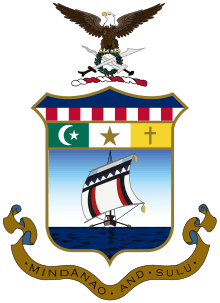Department of Mindanao and Sulu
The Department of Mindanao and Sulu was an agency of the United States colonial administration in the Philippine Islands tasked to administer all Muslim-dominated areas in the territory. It was established on July 23, 1914, pursuant to Act No. 2408, replacing the Moro Province after the latter was divided into the then districts/provinces of Zamboanga, Lanao, Cotabato, Davao, and Sulu.[1] It was later split into provinces/regions organized under the Department of Mindanao and Sulu, along with the former provinces of Agusan, Surigao and current province of Bukidnon, but excluding Lanao.[2]
| Department of Mindanao and Sulu | |||||||||||||||||||||
|---|---|---|---|---|---|---|---|---|---|---|---|---|---|---|---|---|---|---|---|---|---|
| Former division of the Philippines | |||||||||||||||||||||
| 1914–1920 | |||||||||||||||||||||
 Coat of arms
| |||||||||||||||||||||
 The modern provinces which were administered by the Department of Mindanao and Sulu | |||||||||||||||||||||
| Historical era | American Occupation | ||||||||||||||||||||
• Established | 1914 | ||||||||||||||||||||
• Disestablished | 1920 | ||||||||||||||||||||
| |||||||||||||||||||||
| Today part of | Agusan del Norte, Agusan del Sur, Bukidnon, Lanao del Norte, Lanao del Sur, Cotabato, Sulu, Zamboanga del Norte, Zamboanga del Sur, Zamboanga Sibugay, South Cotabato, Davao de Oro, Davao del Norte, Davao del Sur, Davao Occidental, Davao Oriental, Maguindanao, Sarangani, Zamboanga City, Iligan, Cotabato City, General Santos, Butuan, and Davao City. | ||||||||||||||||||||
Government
A civil government replaced the Moro Province's government. The Legislative Council was replaced with an advisory body called the Administrative Council and its legislative power was diverted to the Philippine Commission.
The provincial government of the seven provinces was vested in a Provincial Board to be composed of a governor, a secretary-treasurer, and a third member. The governor and the secretary-treasurer is appointed by the Department governor subject to the confirmation of the Governor-General. The third member is elected by the presidents and councilors of all the municipal districts of province.
Suffrage
The right to vote for the municipal officers was given to males of at least twenty-five (25) years of age with at least six (6) months legal residence in the town. One who held a position before the American occupation; had an annual property worth ₱500.00 or paid at least ₱30.00 in taxes annually; and could spell, read or write English or Spanish.
Abolition
It was eventually abolished in 1920, after the responsibility for the administration of Moro lands was transferred to the Bureau of Non-Christian Tribes of the Philippines' Department of the Interior. It was headed by a governor, subordinate to the U.S. Governor-General of the Philippine Islands. Frank C. Carpenter served as its governor from 1914 to 1920.
References
- Jose Arnaldo Dris. "Maguindanao". Archived from the original on January 1, 2006. Retrieved August 9, 2007.
- "The Moro Lands". web.archive.org. Archived from the original on July 29, 2009. Retrieved April 28, 2019.
- North Cotabato – Overview of its Past, People & Resources. Accessed on February 5, 2007.